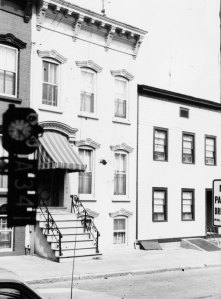
On Memorial Day evening, 1962, Samuel Clark was double-parked in front of his mother’s Jefferson St. home. With his sister, Thelma Wilson, he was unpacking picnic gear from a family excursion to Six Mile Waterworks, when a police cruiser screeched to a stop, dangerously close to Thelma. Alarmed, the two siblings complained to Patrolman Paul Loomis. The police officer got angry, and the conflict quickly escalated.
Thelma Wilson described the scene:
The officer … said, “What are you trying to do? Are you saying I don’t know how to drive? Now get that car out of here.” He was yelling at us and the next thing you know they were arguing. Sam said he’s done nothing wrong and that we’re just unloading the car. The officer then says, “You’re under arrest!” to him and tells him to get in the police car. He pulls a stick out but Sam says, “You don’t need that. I’m not going to do anything. I haven’t done anything wrong.” I said the same thing. A crowd was soon watching the whole thing. The officer says, “Shut up lady. Do you want to get arrested too?”
Patrolman Loomis brought Samuel Clark to Second Division police headquarters on the corner of Arch and Broad streets, where he was charged with disorderly conduct and held until after midnight. As soon as Clark was freed on bail, his family drove him to the emergency room at St. Peter’s Hospital. He was suffering from injuries to his head, eyes, and leg and would remain hospitalized for the next six days.
This event followed a pattern identified by Harvard political scientist James Q. Wilson in his seminal 1968 book, Varieties of Police Behavior. The predominantly white Albany police department practiced what Wilson called a “watchman style” of policing, focused on maintaining order rather than enforcing the law. Overall, arrests of local residents were low, except when it came to black men, who were charged with “disorderly conduct” or “drunkenness” in numbers disproportionate to their population. Wilson theorized that the police regarded African Americans as outsiders and, therefore, in need of restraint. Furthermore, he observed, “a perceived challenge to police authority is met forcefully.” During the course of his research, Wilson interviewed several Albany men who complained of physical and verbal abuse while in police custody.
The day after Samuel Clark’s arrest, Knickerbocker News reporter Ed Swietnicki told his editors that he planned to investigate the case. Swietnicki would later testify that for the past two years he had been looking for a local story that would highlight police brutality. Under publisher Gene Robb’s leadership, the newspaper’s 1960 merger with the Times Union had resulted in a new willingness to challenge the O’Connell-Corning status quo. The Clark case was an ideal vehicle for such a challenge. Samuel Clark was a postal employee and World War II veteran with a squeaky clean record. And there were witnesses. Swietnicki’s exposé was front-page news.
Along with the Knick News, the local branch of the NAACP helped shine a light on the problem of police brutality. The branch’s size and influence had grown rapidly as the Great Migration gained steam. Its leaders met with Mayor Erastus Corning and Police Chief John Tuffey, pressuring them to act. The NAACP also organized a Sunday prayer meeting on the steps of City Hall. Although the day was hot and humid, roughly 350 protestors showed up.

Bowing to pressure, Police Commissioner James Kirwin convened a public inquiry, and District Attorney John Garry opened a grand jury investigation. Not surprisingly, after several days of testimony, Commissioner Kirwin dismissed the charges against Patrolman Loomis and his fellow officers for lack of proof. Furthermore, Kirwin questioned the severity of Clark’s injuries, suggesting he was guilty of malingering and, by extension, of setting off what the defendants’ lawyer described as “mass hysteria.” In a separate Police Court hearing, Clark was found guilty of disorderly conduct and fined $25.

That fall, the grand jury indicted not the police but the reporter, charging Ed Swietnicki with perjury. Clark, who at the time was suing the city for $100,000 in damages, took the advice of his lawyer, Peter Pryor, and refused to testify without immunity. That decision probably saved Clark further harassment. The Swietnicki case remained unresolved until January 1964, when the reporter was finally acquitted.
The Clark case didn’t end the problem of police brutality in Albany. But it did reveal the power of political organizing and press freedom to expose the racism and violence at the Machine’s heart.
The case sure did not end the problem.
LikeLiked by 1 person
Unfortunately, it did not.
LikeLike